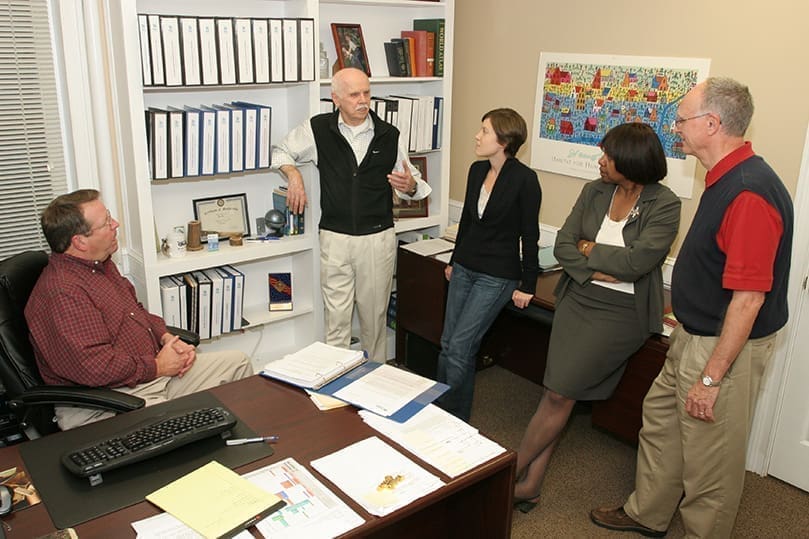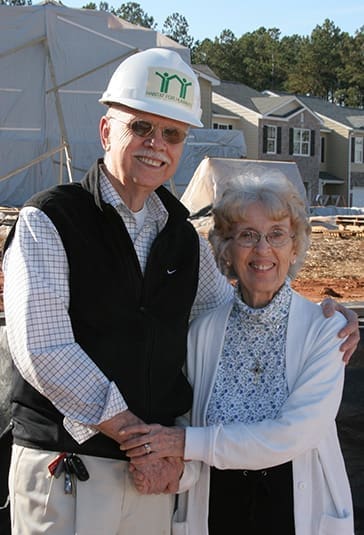 Photo By Michael Alexander
Photo By Michael AlexanderRoswell
Habitat Home-Building Still Impels 25-Year Volunteer
By GRETCHEN KEISER, Staff Writer | Published November 26, 2009
Gene Stelten opens the first page of a weathered scrapbook.
It isn’t pictures of his wife, Jeannie, their five children or their grandchildren, but it’s obviously family in his heart.
It starts in 1984. A colleague writes him about a new thing in Atlanta called Habitat for Humanity and says, “It’s right down your alley.”
“Boy, was he right,” Stelten, 81, grins and says.
Based on that letter, he showed up 25 years ago at the first Habitat home-building site in Atlanta, near where Turner Field now stands. Volunteering for Habitat was so new, the job supervisor asked Stelten why he came.
He was the only volunteer that day. He saw burglar bars for the first time in his life.
He worked with Michael and Venice Bates, the future homeowners, as they built the house the way Habitat homes are done: “sweat equity” by the family who will live there, volunteers and skilled supervisors helping to build the home, and an interest-free, no-profit, 30-year mortgage that the family pays. It leads to home ownership for them and feeds a fund to help launch the next Habitat house.
“That was a great day,” the octogenarian reminisces. “I got to work side by side with a poor family and help them build their house. It taught me what a house means to a poor family.”
At the time he was active at Holy Spirit Church and selling electronic equipment for Motorola. Trained in electrical engineering at the University of Cincinnati, he was transferred to Atlanta in 1964. His children “all grew up here and went to school here. We just loved it in Georgia, and we decided to stay.”
In those early years, he once saw Klansmen in robes sitting at a lunch counter, while black people were kept outside, where they stood and sang, “We Shall Overcome.”
“I was really shocked,” Stelten said.
He learned from the Bates family at the job site in 1984 that a home of their own meant many things: privacy, safety, self-esteem. Bottom line, a home meant a place for their children to study and have a chance to succeed.
“I thought, wow, this is where the action should be,” Stelten said. “We want people to break out of poverty. I guess I got kind of hooked. I didn’t think there was a better way to eradicate poverty than to help people get a home of their own.”
From that point forward he has no idea how many hundreds of Habitat homes he has worked on, but he told Habitat founder Millard Fuller “you changed my life.”
“I kept a scrapbook of every house I worked on for the first five years. Then we started building five houses a year, 10 houses a year. (The scrapbooks) got out of control. I stopped doing that years ago.”
The passion was shared by his family.
“The great thing is I had a chance to take each one of my children with me. What an opportunity for a teenager—to work with a poor family to see what a home means to a family. It is a great training ground.”
“Each of my other children has been involved in Habitat and helped.”
$30,000 Built A House In 1994
Building was what he really liked, “being out there on Saturdays” at the sites, but he wanted to do more. When he retired and he and Jeannie moved to Alpharetta, he helped found the north Fulton Habitat chapter, now called Habitat of North Central Georgia.
“We had to raise our own funds, find our own families, buy our own properties,” he said, since they were now their own affiliate, not part of the Atlanta chapter.
“The first house we built, I went to my pastor, Father (Albert) Jowdy, (at St. Thomas Aquinas Church) and asked for $10,000.”
“We got $30,000; $30,000 built a house in 1994, bought the property and everything,” he said. “It was the easiest money I’ve ever raised.”
“For about five years I was the chairman of the (Habitat of north Fulton County) development committee for churches. It was my job to knock on the door of every church in north Fulton, and I did.”
He once went to a mosque where he knew no one and explained Habitat to a few members who were there the day he came.
“They gave us funds and sent volunteers to work with us the very next year. I remember their imam came out and worked with us in his white robe and skullcap. We thought that was great. We celebrated that.”
“The churches are the easiest ones to sign up for Habitat. They all believe in it and want to be part of it.”
“We started the ecumenical build about 10 years ago. We have Catholic, Baptist, Episcopal, Methodist, Presbyterian, Lutheran, all these churches working together on a Saturday to build a house for a needy family. … That is really an exciting build. We do that every year.”

Gene and Jeannie Stelten stand on the site of one of Habitat’s most recent building projects, Centennial Village of Milton. The Steltens are Cincinnati, Ohio natives who have been married for 57 years. Photo By Michael Alexander
Habitat of North Central Georgia staff member Kristyn Johnson says Stelten has raised hundreds of thousands of dollars to build Habitat homes.
Randy Redner, executive director of that chapter from 2000 to 2005, said, “Who is going to turn down Gene?”
“He could tell the (Habitat) story,” Redner said.
When Stelten approached someone for help, it was never presented as a request for money. He would say, “We need to build this house for the Smith family. Here’s a picture of their boys.”
Redner was drawn to work for Habitat after riding around with Stelten, who was showing him some of their completed homes.
“He could tell me every name of every family and the names of their children—he just really knew. That’s the heart of what Habitat for Humanity would do.”
“He is a great man and they (the Steltens) are a great family. … With Gene first and foremost it is the servant’s heart he comes with. It is always out there, always on his sleeve. He is always asking, what can I do. I am going to do it, come rain or come shine.”
“He was the energizer bunny. He was never scared of asking anybody for any money anywhere. … He was just relentless. He would never give up. He would never get down.”
On the outside, things at Habitat might always look good. On the inside, Redner said, there were the times just before a build was to start when he and Gene would be sitting together and they knew the sponsorship money essential to start a house wasn’t there.
Then “in would come the check. We knew a much higher power than Gene or me was involved in Habitat.”
Running a Habitat program is daunting and requires faith, Redner said. The people who are involved are essentially doing five tasks—real estate broker, developer, fund-raiser, mortgage broker, social worker—any one of which could be a full-time enterprise.
The Steltens at times were dealing with illness and difficulties. “You would never know it. He has so much faith and Jeannie too and the children. They believe in the Lord and that He has things in control.”
“He is so far along in his walk with Jesus Christ that it is just who he is. My faith grew while I was there working, not only with Gene but with others,” Redner said.
“Always got a smile on his face and saying, we’ll figure that out. God’s blessed him so many times, he just assumes it is going to be OK.”
‘I Could Do That’
Relentlessness led Stelten to find a new way to raise funds for Habitat. One day in a bookstore he saw a collection of stories written by celebrities with all the proceeds going to charity.
“I said ‘I could do that.’”
He did it three times.
The first was a collection of about 60 Christmas stories he cajoled from famous Georgians, called “A Christmas Housewarming,” that Peachtree Publishers released in 1992. It sold 18,000 copies.
At the publisher’s suggestion, he did a second book three years later of Christmas stories by national figures, including Maya Angelou, Terry Kay, Cardinal Joseph Bernardin, Charlton Heston, Tommy Lasorda, Joe Paterno, Barbara Bush and Hillary Clinton, called “Home for the Holidays.” It sold 48,000 copies.
The books have raised another $100,000 for Habitat and are all still in print.
Now he and Jeannie live at St. George Village in Roswell, a Catholic-sponsored retirement community, and he has just published his first children’s book called “A House for Wally and Me.”
Eighty percent of the proceeds benefit North Central Georgia Habitat. Twenty percent goes to Habitat in Asheville, N.C., where the publisher, Grateful Steps, is based.
Told from a child’s point of view, it is about a young girl and her family coming to have a home through Habitat. The story includes building photographs, original art by Pratt Institute student Chelsea Johnson, and some discussion questions and practical tips for children on what goes into building a house.
How does this connect with Stelten’s Catholic faith?
“It’s directly related because I am stressing in the book how people of different backgrounds can work together for the poor.”
“That’s what my faith teaches me: serving others is right at the top of the list.”
“I want it to help children see people working together from all backgrounds, racial, religious, economic, all people working together to help a needy family and I want the book to give parents and teachers a way to help teach the children acts of kindness.”
Looking back on 25 years working with Habitat, he says, “It developed working next to Michael and Venice Bates and seeing what they needed. They didn’t need a big church. They needed a home where they could raise their kids and break out of poverty.”
He thinks it is the tangible part of Habitat that hooked him.
“Habitat is something you can see happening. You can watch a house come out of the ground and then think—hmmm. I can help this happen for people.”
“It is so much different than putting money in an envelope and mailing it off to somebody.”
“To me the essence of it is the partnership between the homeowners, the volunteers and the sponsors all working together. And everybody wins. The homeowners get a house, the sponsors see a home coming out of the ground right away, and the volunteers win because they get to work side by side with a poor family and they get that satisfaction of helping.”
Currently North Central Georgia Habitat is building in the city of Milton near Windward Parkway. They are building four- and five-unit townhouses into a 29-home community that is being constructed in phases. The first phase was completed in 2007 and the final phases are scheduled to start and finish in 2010.
Gene has his book-signing pen poised over the inside flap of his new book.
“We’re trying to sell 8,000 books,” he said. “Eight thousand will build a complete house.”